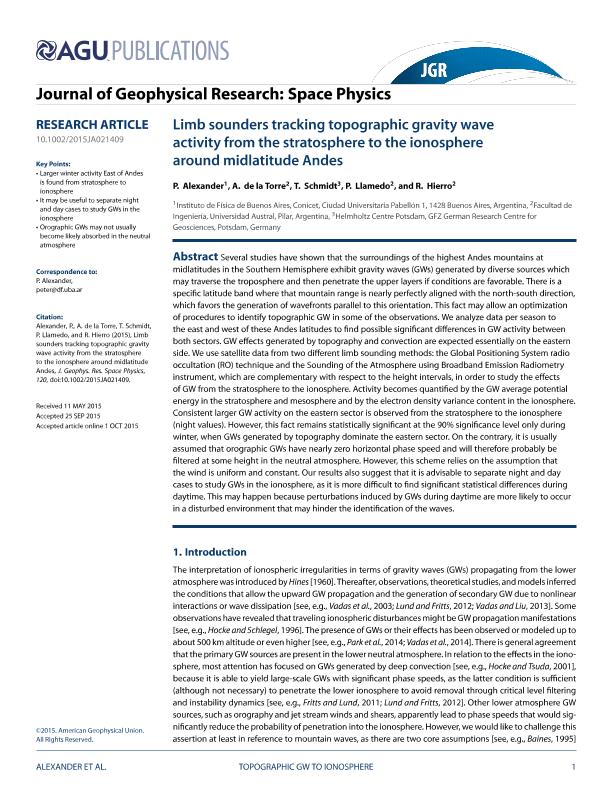Artículo
Limb sounders tracking topographic gravity wave activity from the stratosphere to the ionosphere around midlatitude Andes
Alexander, Pedro Manfredo ; de la Torre, Alejandro
; de la Torre, Alejandro ; Schmidt, T.; Llamedo Soria, Pablo Martin
; Schmidt, T.; Llamedo Soria, Pablo Martin ; Hierro, Rodrigo Federico
; Hierro, Rodrigo Federico
 ; de la Torre, Alejandro
; de la Torre, Alejandro ; Schmidt, T.; Llamedo Soria, Pablo Martin
; Schmidt, T.; Llamedo Soria, Pablo Martin ; Hierro, Rodrigo Federico
; Hierro, Rodrigo Federico
Fecha de publicación:
10/2015
Editorial:
American Geophysical Union
Revista:
Journal of Geophysical Research
ISSN:
0148-0227
Idioma:
Inglés
Tipo de recurso:
Artículo publicado
Clasificación temática:
Resumen
Several studies have shown that the surroundings of the highest Andes mountains at midlatitudes in the Southern Hemisphere exhibit gravity waves (GWs) generated by diverse sources which may traverse the troposphere and then penetrate the upper layers if conditions are favorable. There is a specific latitude band where that mountain range is nearly perfectly aligned with the north‐south direction, which favors the generation of wavefronts parallel to this orientation. This fact may allow an optimization of procedures to identify topographic GW in some of the observations. We analyze data per season to the east and west of these Andes latitudes to find possible significant differences in GW activity between both sectors. GW effects generated by topography and convection are expected essentially on the eastern side. We use satellite data from two different limb sounding methods: the Global Positioning System radio occultation (RO) technique and the Sounding of the Atmosphere using Broadband Emission Radiometry instrument, which are complementary with respect to the height intervals, in order to study the effects of GW from the stratosphere to the ionosphere. Activity becomes quantified by the GW average potential energy in the stratosphere and mesosphere and by the electron density variance content in the ionosphere. Consistent larger GW activity on the eastern sector is observed from the stratosphere to the ionosphere (night values). However, this fact remains statistically significant at the 90% significance level only during winter, when GWs generated by topography dominate the eastern sector. On the contrary, it is usually assumed that orographic GWs have nearly zero horizontal phase speed and will therefore probably be filtered at some height in the neutral atmosphere. However, this scheme relies on the assumption that the wind is uniform and constant. Our results also suggest that it is advisable to separate night and day cases to study GWs in the ionosphere, as it is more difficult to find significant statistical differences during daytime. This may happen because perturbations induced by GWs during daytime are more likely to occur in a disturbed environment that may hinder the identification of the waves.
Palabras clave:
Gravity Waves
,
Gps Radio Occultation
,
Andes Mountains
,
Ionosphere
Archivos asociados
Licencia
Identificadores
Colecciones
Articulos(SEDE CENTRAL)
Articulos de SEDE CENTRAL
Articulos de SEDE CENTRAL
Citación
Alexander, Pedro Manfredo; de la Torre, Alejandro; Schmidt, T.; Llamedo Soria, Pablo Martin; Hierro, Rodrigo Federico; Limb sounders tracking topographic gravity wave activity from the stratosphere to the ionosphere around midlatitude Andes; American Geophysical Union; Journal of Geophysical Research; 120; 10; 10-2015; 9014-9022
Compartir
Altmétricas



